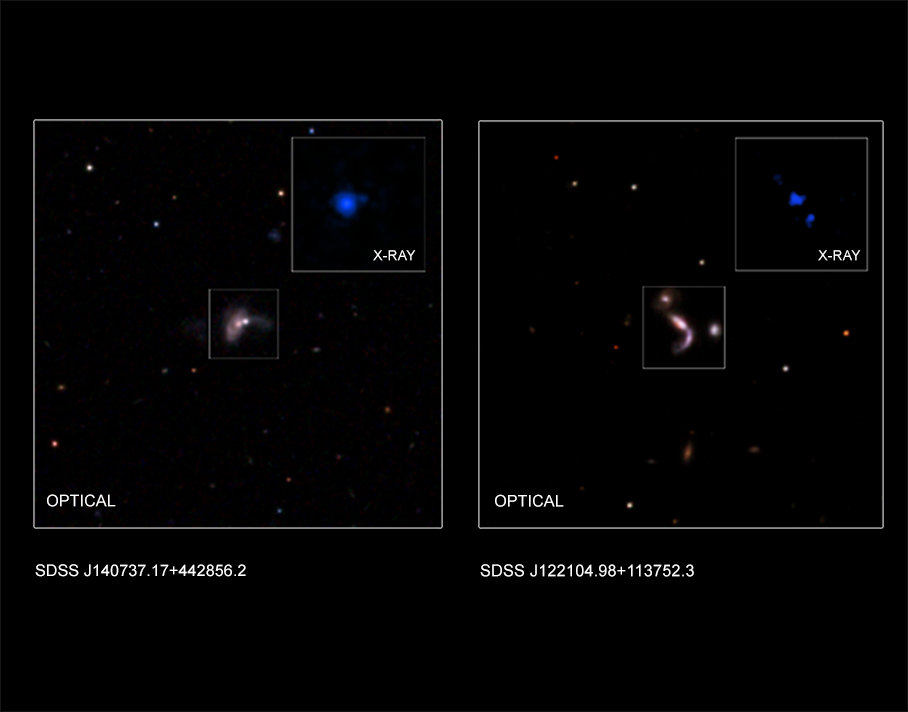Astronomers, including one of Indian-origin, have identified five pairs of supermassive black holes, each millions of times the mass of the Sun, in the centres of galaxies. Scientists believe that the discovery could help better understand the phenomenon of gravitational waves - ripples in the fabric of space and time.
These black hole couples formed when two galaxies merged with each other after collision, forcing their supermassive black holes close together.
The findings could help astronomers better understand how giant black holes grow and how they may produce the strongest gravitational wave signals in the universe.
Researchers said the black hole pairs were uncovered by combining data from a suite of different observatories including NASA's Chandra X-ray Observatory, the Wide-Field Infrared Sky Explorer Survey (WISE), and the ground-based Large Binocular Telescope in Arizona.
"Astronomers find single supermassive black holes all over the universe," said Shobita Satyapal, from George Mason University in the Fairfax, Virginia. "But even though we've predicted they grow rapidly when they are interacting, growing dual supermassive black holes have been difficult to find."
Satyapal led one of two papers describing these results. Four of the dual black hole candidates were reported in a paper led by Satyapal that was published online in The Astrophysical Journal.
Optical data from the Sloan Digital Sky Survey (SDSS) was used to identify galaxies where it appeared that a merger between two smaller galaxies was underway.
From this set, researchers selected objects where the separation between the centers of the two galaxies in the SDSS data is less than 30,000 light years, and the infrared colors from WISE data match those predicted for a rapidly growing supermassive black hole.
Seven merging systems containing at least one supermassive black hole were found with this technique, researchers said.
Since strong X-ray emission is a hallmark of growing supermassive black holes, researchers then observed these systems with Chandra.
Closely-separated pairs of X-ray sources were found in five systems, providing compelling evidence that they contain two growing (or feeding) supermassive black holes.
Both the X-ray data from Chandra and the infrared observations suggest that the supermassive black holes are buried in large amounts of dust and gas.
The other dual black hole candidate was reported in a paper led by Sara Ellison of the University of Victoria in Canada which was published in the journal Monthly Notices of the Royal Astronomical Society.
"Our work shows that combining the infrared selection with X-ray follow-up is a very effective way to find these black hole pairs," Ellison said.
"X-rays and infrared radiation are able to penetrate the obscuring clouds of gas and dust surrounding these black hole pairs, and Chandra's sharp vision is needed to separate them," she said.
One member of this black hole pair is particularly powerful, having the highest X-ray luminosity in a black hole pair observed by Chandra to date.
The research has implications for the burgeoning field of gravitational wave astrophysics. Before this study fewer than ten confirmed pairs of growing black holes were known from X-ray studies, based mostly on chance detections.
To carry out a systematic search, the team had to carefully sift through data from telescopes that detect different wavelengths of light.
While scientists using the Laser Interferometer Gravitational-Wave Observatory (LIGO) and the VIRGO interferometer have detected the signals of merging black holes, these black holes have been of the smaller variety weighing between about eight and 36 times the mass of the Sun.
The merging black holes in the centres of galaxies are much larger. When these supermassive black holes draw even closer together, they should start producing gravitational waves.
The eventual merger of the dual supermassive black holes in hundreds of millions of years would forge an even bigger black hole.
This process would produce an astonishing amount of energy when some of the mass is converted into gravitational waves.
"It is important to understand how common supermassive black hole pairs are, to help in predicting the signals for gravitational wave observatories," Satyapal said.
"With experiments already in place and future ones coming online, this is an exciting time to be researching merging black holes. We are in the early stages of a new era in exploring the universe," Satyapal added.

